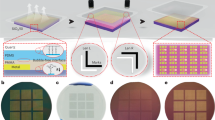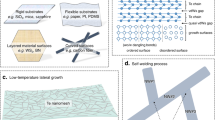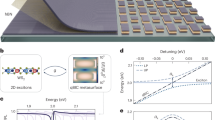Abstract
Molecular intercalation-based electrochemical exfoliation of two-dimensional (2D) materials can be used to create van der Waals heterostructures. However, the scalable assembly of vertical heterostructures typically requires the use of various chemical solvents for photolithography and subsequent transfer, which can leave behind chemical residues and limit the patterning resolution. We show that patterned van der Waals heterostructures can be fabricated from electrochemically exfoliated 2D flakes using a photoreactive crosslinker. When a 2D van der Waals percolated network with the crosslinker is exposed to ultraviolet light, the network junctions form covalent bonds, thereby enabling improved charge transport and orthogonal patterning of vertically stacked van der Waals thin-film networks without affecting the underlying prepatterned layers. Our approach can be used to create wafer-scale arrays of photopatterned field-effect transistors based on different 2D materials. The field-effect transistors exhibit high spatial uniformity and can be used to create logic gates, namely NOT, NAND and NOR gates.
This is a preview of subscription content, access via your institution
Access options
Access Nature and 54 other Nature Portfolio journals
Get Nature+, our best-value online-access subscription
$32.99 / 30 days
cancel any time
Subscribe to this journal
Receive 12 digital issues and online access to articles
$119.00 per year
only $9.92 per issue
Buy this article
- Purchase on SpringerLink
- Instant access to full article PDF
Prices may be subject to local taxes which are calculated during checkout




Similar content being viewed by others
Data availability
The data that supports the findings of this study are available from the corresponding authors upon reasonable request.
References
Lemme, M. C., Akinwande, D., Huyghebaert, C. & Stampfer, C. 2D materials for future heterogeneous electronics. Nat. Commun. 13, 1392 (2022).
Novoselov, K. S., Mishchenko, A., Carvalho, A. & Castro Neto, A. H. 2D materials and van der Waals heterostructures. Science 353, aac9439 (2016).
Coleman, J. N. et al. Two-dimensional nanosheets produced by liquid exfoliation of layered materials. Science 331, 568–571 (2011).
Zhang, X. et al. Facile synthesis of solution-processed MoS2 nanosheets and their application in high-performance ultraviolet organic light-emitting diodes. J. Mater. Chem. C 7, 926–936 (2019).
Li, D., Müller, M. B., Gilje, S., Kaner, R. B. & Wallace, G. G. Processable aqueous dispersions of graphene nanosheets. Nat. Nanotechnol. 3, 101–105 (2008).
Kim, J. et al. Solution-processed MoS2 film with functional interfaces via precursor-assisted chemical welding. ACS Appl. Mater. Interfaces 13, 12221–12229 (2021).
Kim, J. et al. All-solution-processed van der Waals heterostructures for wafer-scale electronics. Adv. Mater. 34, 2106110 (2022).
Liu, Q. et al. Gram-scale aqueous synthesis of stable few-layered 1T-MoS2: applications for visible-light-driven photocatalytic hydrogen evolution. Small 11, 5556–5564 (2015).
Ciesielski, A. & Samorì, P. Graphene via sonication assisted liquid-phase exfoliation. Chem. Soc. Rev. 43, 381–398 (2014).
Lin, Z. et al. Solution-processable 2D semiconductors for high-performance large-area electronics. Nature 562, 254–258 (2018).
Knobloch, T. et al. Improving stability in two-dimensional transistors with amorphous gate oxides by Fermi-level tuning. Nat. Electron. 5, 356–366 (2022).
Li, M. et al. High mobilities in layered InSe transistors with indium-encapsulation-induced surface charge doping. Adv. Mater. 30, 1803690 (2018).
Sebastian, A., Pendurthi, R., Choudhury, T. H., Redwing, J. M. & Das, S. Benchmarking monolayer MoS2 and WS2 field-effect transistors. Nat. Commun. 12, 693 (2021).
Deng, T. et al. Three-dimensional graphene field-effect transistors as high-performance photodetectors. Nano Lett. 19, 1494–1503 (2019).
Wu, D. et al. Highly polarization-sensitive, broadband, self-powered photodetector based on graphene/PdSe2/germanium heterojunction. ACS Nano 13, 9907–9917 (2019).
Kwon, Y. A. et al. Wafer-scale transistor arrays fabricated using slot-die printing of molybdenum disulfide and sodium-embedded alumina. Nat. Electron. 6, 443–450 (2023).
Rhee, D., Jariwala, D., Cho, J. H. & Kang, J. Solution-processed 2D van der Waals networks: Fabrication strategies, properties, and scalable device applications. Appl. Phys. Rev. 11, 021310 (2024).
Song, O. et al. All inkjet-printed electronics based on electrochemically exfoliated two-dimensional metal, semiconductor, and dielectric. npj 2D Mater. Appl. 6, 64 (2022).
Bae, S.-H. et al. Integration of bulk materials with two-dimensional materials for physical coupling and applications. Nat. Mater. 18, 550–560 (2019).
Hong, X. et al. Ultrafast charge transfer in atomically thin MoS2/WS2 heterostructures. Nat. Nanotechnol. 9, 682–686 (2014).
Cao, Y. et al. Correlated insulator behaviour at half-filling in magic-angle graphene superlattices. Nature 556, 80–84 (2018).
Cao, Y. et al. Unconventional superconductivity in magic-angle graphene superlattices. Nature 556, 43–50 (2018).
Tran, K. et al. Evidence for moiré excitons in van der Waals heterostructures. Nature 567, 71–75 (2019).
Zhang, C. et al. Interlayer couplings, moiré patterns, and 2D electronic superlattices in MoS2/WSe2 hetero-bilayers. Sci. Adv. 3, e1601459 (2017).
Tong, L. et al. Heterogeneous complementary field-effect transistors based on silicon and molybdenum disulfide. Nat. Electron. 6, 37–44 (2023).
Quellmalz, A. et al. Large-area integration of two-dimensional materials and their heterostructures by wafer bonding. Nat. Commun. 12, 917 (2021).
Geim, A. K. & Grigorieva, I. V. Van der Waals heterostructures. Nature 499, 419–425 (2013).
Luo, P. et al. Molybdenum disulfide transistors with enlarged van der Waals gaps at their dielectric interface via oxygen accumulation. Nat. Electron. 5, 849–858 (2022).
Yang, X. et al. Highly reproducible van der Waals integration of two-dimensional electronics on the wafer scale. Nat. Nanotechnol. 18, 471–478 (2023).
Chang, S., Yan, Y. & Geng, Y. Manipulating nanopatterns on two-dimensional MoS2 monolayers via atomic force microscopy-based thermomechanical nanolithography for optoelectronic device fabrication. ACS Appl. Nano Mater. 6, 8346–8357 (2023).
Cho, S. R. et al. Universal patterning for 2D van der Waals materials via direct optical lithography. Adv. Funct. Mater. 31, 2105302 (2021).
Enrico, A. et al. Ultrafast and resist-free nanopatterning of 2D materials by femtosecond laser irradiation. ACS Nano 17, 8041–8052 (2023).
Li, T. et al. Reconfigurable, non-volatile neuromorphic photovoltaics. Nat. Nanotechnol. 18, 1303–1310 (2023).
Bolshakov, P. et al. Contact engineering for dual-gate MoS2 transistors using O2 plasma exposure. ACS Appl. Electron. Mater. 1, 210–219 (2019).
Garcia, A. G. F. et al. Effective cleaning of hexagonal boron nitride for graphene devices. Nano Lett. 12, 4449–4454 (2012).
Sun, X. et al. Reconfigurable logic-in-memory architectures based on a two-dimensional van der Waals heterostructure device. Nat. Electron. 5, 752–760 (2022).
McManus, D. et al. Water-based and biocompatible 2D crystal inks for all-inkjet-printed heterostructures. Nat. Nanotechnol. 12, 343–350 (2017).
Carey, T. et al. Fully inkjet-printed two-dimensional material field-effect heterojunctions for wearable and textile electronics. Nat. Commun. 8, 1202 (2017).
Nguyen, V. L. et al. Wafer-scale integration of transition metal dichalcogenide field-effect transistors using adhesion lithography. Nat. Electron. 6, 146–153 (2023).
Kim, M. J. et al. Universal three-dimensional crosslinker for all-photopatterned electronics. Nat. Commun. 11, 1520 (2020).
Kwak, I. C. et al. Solid-state homojunction electrochemical transistors and logic gates on plastic. Adv. Funct. Mater. 33, 2211740 (2023).
Syari’ati, A. et al. Photoemission spectroscopy study of structural defects in molybdenum disulfide (MoS2) grown by chemical vapor deposition (CVD). Chem. Commun. 55, 10384–10387 (2019).
Kim, J. et al. Area-selective chemical doping on solution-processed MoS2 thin-film for multi-valued logic gates. Nano Lett. 22, 570–577 (2022).
Kim, K. S. et al. Ultrasensitive MoS2 photodetector by serial nano-bridge multi-heterojunction. Nat. Commun. 10, 4701 (2019).
Ferrari, A. C. et al. Raman spectrum of graphene and graphene layers. Phys. Rev. Lett. 97, 187401 (2006).
Nie, X.-R. et al. Impact of metal contacts on the performance of multilayer HfS2 field-effect transistors. ACS Appl. Mater. Interfaces 9, 26996–27003 (2017).
Zhu, J. et al. Solution-processed dielectrics based on thickness-sorted two-dimensional hexagonal boron nitride nanosheets. Nano Lett. 15, 7029–7036 (2015).
Mondal, A. et al. Low ohmic contact resistance and high on/off ratio in transition metal dichalcogenides field-effect transistors via residue-free transfer. Nat. Nanotechnol. 19, 34–43 (2024).
Acknowledgements
This work was supported by a National Research Foundation of Korea (NRF) grant funded by the Korean Government (MSIT) (Grant Numbers RS-2023-00234581, RS-2023-00208538, RS-2023-00237308 and RS-2023-00276201). M.S.K. acknowledges support from the Nano & Material Technology Development Program (RS-2024-00445116) of the NRF funded by the Ministry of Science and ICT, Korea. V.M. was supported by project LUAUS23049 from the Ministry of Education Youth and Sports. Z.S. was supported by the ERC-CZ programme (Project LL2101) of the Ministry of Education Youth and Sports and used a large piece of infrastructure from Project Reg. Number CZ.02.1.01/0.0/0.0/15_003/0000444 financed by the EFRR.
Author information
Authors and Affiliations
Contributions
J.H.C. and J. Kang initiated and supervised all the research. I.C.K. and J. Kim conducted and designed most of the experimental work and data analysis. J.W.M., S.K., H.J. and S.Y.P. assisted with the data analysis. J.Y.P., O.S., V.M. and Z.S. synthesized the materials. M.S.K. assisted with paper writing. All authors contributed to the writing of the paper. All authors discussed the progress of the research and contributed to editing the paper.
Corresponding authors
Ethics declarations
Competing interests
The authors declare no competing interests.
Peer review
Peer review information
Nature Electronics thanks Yuerui Lu, Ning Wang and the other, anonymous, reviewer(s) for their contribution to the peer review of this work.
Additional information
Publisher’s note Springer Nature remains neutral with regard to jurisdictional claims in published maps and institutional affiliations.
Supplementary information
Supplementary Information
Supplementary Tables 1 and 2 and Figs. 1–23.
Rights and permissions
Springer Nature or its licensor (e.g. a society or other partner) holds exclusive rights to this article under a publishing agreement with the author(s) or other rightsholder(s); author self-archiving of the accepted manuscript version of this article is solely governed by the terms of such publishing agreement and applicable law.
About this article
Cite this article
Kwak, I.C., Kim, J., Moon, J.W. et al. Orthogonal photopatterning of two-dimensional percolated network films for wafer-scale heterostructures. Nat Electron 8, 235–243 (2025). https://doi.org/10.1038/s41928-025-01351-z
Received:
Accepted:
Published:
Issue date:
DOI: https://doi.org/10.1038/s41928-025-01351-z
This article is cited by
-
Mechanically reliable and electronically uniform monolayer MoS2 by passivation and defect healing
Nature Communications (2025)
-
Low-dimensional materials for bioelectronic devices
Nature Reviews Bioengineering (2025)
-
Scalable heterostructures using photoresist-free patterning
Nature Electronics (2025)



